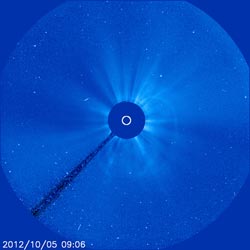Sun Spits Out A Coronal Mass Ejection

The Solar and Heliospheric Observatory (SOHO) captured this image of the sun at 5:06 a.m. EDT on Oct 5, 2012 showing a coronal mass ejection (CME) spreading away from the sun toward Earth. Credit: SOHO (ESA & NASA) <br>
Not to be confused with a solar flare, which is a burst of light and radiation, CMEs are a phenomenon that can send solar particles into space and can reach Earth one to three days later.
Experimental NASA research models show the CME to be traveling at about 400 miles per second.
When Earth-directed, CMEs can affect electronic systems in satellites and on Earth. CMEs of this speed, however, have not generally caused major effects in the past. Further updates will be provided if needed.
NOAA's Space Weather Prediction Center (http://swpc.noaa.gov) is the United States Government official source for space weather forecasts.
What is a CME?
For answers to this and other space weather questions, please visit the Spaceweather Frequently Asked Questions page.
Karen C. Fox
NASA Goddard Space Flight Center, Greenbelt, MD
Media Contact
More Information:
http://www.nasa.gov/mission_pages/sunearth/news/News100512-cme.htmlAll latest news from the category: Earth Sciences
Earth Sciences (also referred to as Geosciences), which deals with basic issues surrounding our planet, plays a vital role in the area of energy and raw materials supply.
Earth Sciences comprises subjects such as geology, geography, geological informatics, paleontology, mineralogy, petrography, crystallography, geophysics, geodesy, glaciology, cartography, photogrammetry, meteorology and seismology, early-warning systems, earthquake research and polar research.
Newest articles

A universal framework for spatial biology
SpatialData is a freely accessible tool to unify and integrate data from different omics technologies accounting for spatial information, which can provide holistic insights into health and disease. Biological processes…

How complex biological processes arise
A $20 million grant from the U.S. National Science Foundation (NSF) will support the establishment and operation of the National Synthesis Center for Emergence in the Molecular and Cellular Sciences (NCEMS) at…

Airborne single-photon lidar system achieves high-resolution 3D imaging
Compact, low-power system opens doors for photon-efficient drone and satellite-based environmental monitoring and mapping. Researchers have developed a compact and lightweight single-photon airborne lidar system that can acquire high-resolution 3D…





















